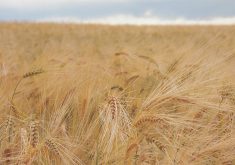CHICAGO (Reuters) — Central U.S. farmland prices held up fairly well this winter, buoyed by a resurgent livestock sector’s need for pasture, and a “soft landing” is likely for the market despite sharp losses in grain prices in 2014, according to a survey by Farm Credit Services of America, one of the biggest U.S. farm lenders.
“Cropland prices in Iowa, Nebraska, South Dakota and Wyoming declined some in the final six months of 2014, while demand for pastureland remained strong,” FCS America said in a statement on Tuesday. “The latest benchmark farm values and sales data tracked continue to point to a ‘soft landing’ for farmland after years of price increases.”
Read Also

U.S. grains: Soy hits 17-month high, corn to four-month top as trade braces for U.S. data
Chicago Board of Trade soybean futures rose on Thursday to their highest in nearly 17 months as traders awaited a U.S. government crop report that was expected to lower yield estimates, while also bracing for the resumption of export data to give clues on Chinese buying.
The Omaha-based lender tracked sales records on 3,447 properties and 64 benchmark farms in the four states surveyed. It issues its survey twice a year.
“It was a break-even year or less than break-even for crop producers, and you’re seeing that reflected in lower land values,” Bill Davis, senior vice-president at FCS America, said in an interview.
“It’s the opposite story in the livestock sector, where we had record profits in cow-calf, beef feedlots and the swine industry last year,” Davis said. “We’re seeing producers that made a lot of money in the cow-calf sector bid pasture or range land prices higher.”
FCS said benchmark land values in Iowa, the top corn and soybean state, were an average 8.8 percent lower year-on-year in January. However, “that followed 10 years of rising land prices, with farmland values still up 196 percent,” it said.
“In areas of Iowa, sale prices remain near historical highs. The highest sale in the fourth quarter of 2014 was (US) $15,300 per acre in Plymouth County,” the lender said.
In Nebraska, a major producer of both grain and beef, farmland values fell 1.7 percent in the last six months of 2014 but were down only 0.2 percent in January of this year from a year earlier. Nebraska farmland values are up nearly 290 percent from 10 years ago.
In nearby grazing states, land values rose. In South Dakota, benchmark values were up 7.8 percent for the year. In Wyoming, values rose nearly seven percent, driven by strong beef calf prices.
Farmers appeared to be holding on to land if they did not need to sell. In 2014, the number of public farmland auctions fell 10 percent in Iowa and 12 percent in Nebraska.














